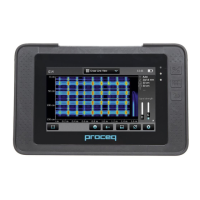31 © 2017 Proceq SA
The basic idea of the potential field measurement is to measure the po-
tentials at the concrete surface, in order to get a characteristic picture of
the state of corrosion of the steel surface within the concrete. For this
purpose a reference electrode is connected via a high-impedance volt-
meter to the steel reinforcement and is moved in a grid over the concrete
surface.
The reference electrode of the Profometer Corrosion system is a Cu/
CuSO
4
half-cell. It consists of a copper rod immersed in a saturated cop-
per sulphate solution, which maintains a constant, known potential.
Figure 35:
Measuring Principle
4.1.2. Typical Potential Range
Typical orders of magnitude (for information only) for the half-cell poten-
tial of steel in concrete measured against a Cu/CuSO
4
reference elec-
trode are in the following range (RILEM TC 154-EMC):
• water saturated concrete without O2: -1000 to -900 mV
• moist, chloride contaminated concrete: -600 to -400 mV
• moist, chloride free concrete: -200 to +100 mV
• moist, carbonated concrete: -400 to +100 mV
• dry, carbonated concrete: 0 to +200 mV
• dry, non-carbonated concrete: 0 to +200 mV
In general terms the probability of corrosion rises with low (negative) po-
tentials; active corrosion can be expected at locations where a negative
potential is surrounded by increasingly positive potentials, i.e. locations
with a positive potential gradient. Potential differences of around +100mV
within a 1m measurement area, together with negative potentials can be
a clear indication of active corrosion.
The actual potential absolute value (corrosion threshold) below which ac-
tive corrosion can be expected may vary significantly on different struc-
tures. It is however useful to mention the thresholds suggested by ASTM C
876-09, Appendix X1, assigning a 90% probability of corrosion ongoing to
the areas more negative than -350 mV, and a 90% probability of no corro-
sion to the areas more positive than -200 mV, judging uncertain the behav-
ior in the regions in between the two thresholds. Be sure to note the con-
ditions stated by ASTM as to the applicability of these threshold values.
4.1.3. Factors affecting the Potential Measurement
Provided that the corrosion conditions are equal (chloride content or car-
bonation of the concrete at the steel surface) the main influences upon
the half-cell potentials are:
Moisture
See the chart above for moist, carbonated concrete and dry, carbonated
concrete. Moisture has a large effect on the measured potential leading
to more negative values.

